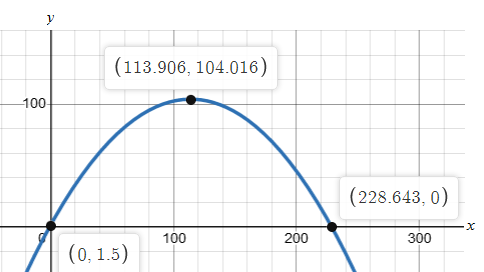
Concept explainers
a.
To graph:The path of th football.
a.
Explanation of Solution
Given:
The equation of the path of football is
Formula/ concept used:
The graph is drawn using graphing calculator.
Graph:
The graph for function (trajectory) is shown in Figure-1 here.

Interpretation of Graph:
The graph of path of football is a parabola with vertex
b.
The height of the football when it is punted.
b.
Answer to Problem 61E
The height of football when it is punted is
Explanation of Solution
Given:
The equation of path of football is
Concept used:
The initial height when football is punted is obtained when
Calculations:
The equation of path of football is
Therefore, the initial vertical position or the height of football when it is punted is
Conclusion:
The height of football when it is punted is
c.
The maximum height of the football.
c.
Answer to Problem 61E
The maximum height of the football is
Explanation of Solution
Given:
The equation of path of football in part (a)
Conceptused:
When the parabola opens downward its
Calculations:
From the graph in part (a), the vertex of the parabola represented by the equation of the path of football
Thus,
The maximum height of the football is
Conclusion:
The maximum height of the football is
d.
The horizontal distance the football strike the ground
d.
Answer to Problem 61E
The football strikes the ground at horizontal distance
Explanation of Solution
Given:
The equation of path of football in part (a).
Formula used:
The football strikes the ground when its vertical height is zero.
Calculations:
The equation of path of footballis
The football will on the ground when
From the graph in part (a) we see that
Thus,the football strikes the ground at horizontal distance
Conclusion:
The football strikes the ground at horizontal distance
e.
To compare: The results from parts (b), (c), and (d).
e.
Answer to Problem 61E
The results obtained parts (b), (c), and (d) are identical.
Explanation of Solution
Given:
The results obtained in parts (b), (c), and (d).
Explanations:
In parts (b), (c), and (d) we find that the area
Thus, the results obtained parts (b), (c), and (d) are identical.
Chapter 2 Solutions
PRECALCULUS W/LIMITS:GRAPH.APPROACH(HS)
- What is the particular solution to the differential equation y′′ + y = 1/cos t ?arrow_forwardWhich of the following is the general solution to y′′ + 4y = e^2t + 12 sin(2t) ?A. y(t) = c1 cos(2t) + c2 sin(2t) + 1/8 e^2t − 3t cos(2t)B. y(t) = c1e^2t + c2e^−2t + 1/4 te^2t − 3t cos(2t)C. y(t) = c1 + c2e^−4t + 1/12 te^2t − 3t cos(2t)D. y(t) = c1 cos(2t) + c2 sin(2t) + 1/8 e^2t + 3 sin(2t)E. None of the above. Please include all steps! Thank you!arrow_forwardShow that i cote +1 = cosec 20 tan 20+1 = sec² O २ cos² + sin 20 = 1 using pythagon's theoremarrow_forward
- Find the general solution to the differential equationarrow_forwardcharity savings Budget for May travel food Peter earned $700 during May. The graph shows how the money was used. What fraction was clothes? O Search Submit clothes leisurearrow_forwardExercise 11.3 A slope field is given for the equation y' = 4y+4. (a) Sketch the particular solution that corresponds to y(0) = −2 (b) Find the constant solution (c) For what initial conditions y(0) is the solution increasing? (d) For what initial conditions y(0) is the solution decreasing? (e) Verify these results using only the differential equation y' = 4y+4.arrow_forward
- Aphids are discovered in a pear orchard. The Department of Agriculture has determined that the population of aphids t hours after the orchard has been sprayed is approximated by N(t)=1800−3tln(0.17t)+t where 0<t≤1000. Step 1 of 2: Find N(63). Round to the nearest whole number.arrow_forward3. [-/3 Points] DETAILS MY NOTES SCALCET8 7.4.032. ASK YOUR TEACHER PRACTICE ANOTHER Evaluate the integral. X + 4x + 13 Need Help? Read It SUBMIT ANSWER dxarrow_forwardEvaluate the limit, and show your answer to 4 decimals if necessary. Iz² - y²z lim (x,y,z)>(9,6,4) xyz 1 -arrow_forward
 Calculus: Early TranscendentalsCalculusISBN:9781285741550Author:James StewartPublisher:Cengage Learning
Calculus: Early TranscendentalsCalculusISBN:9781285741550Author:James StewartPublisher:Cengage Learning Thomas' Calculus (14th Edition)CalculusISBN:9780134438986Author:Joel R. Hass, Christopher E. Heil, Maurice D. WeirPublisher:PEARSON
Thomas' Calculus (14th Edition)CalculusISBN:9780134438986Author:Joel R. Hass, Christopher E. Heil, Maurice D. WeirPublisher:PEARSON Calculus: Early Transcendentals (3rd Edition)CalculusISBN:9780134763644Author:William L. Briggs, Lyle Cochran, Bernard Gillett, Eric SchulzPublisher:PEARSON
Calculus: Early Transcendentals (3rd Edition)CalculusISBN:9780134763644Author:William L. Briggs, Lyle Cochran, Bernard Gillett, Eric SchulzPublisher:PEARSON Calculus: Early TranscendentalsCalculusISBN:9781319050740Author:Jon Rogawski, Colin Adams, Robert FranzosaPublisher:W. H. Freeman
Calculus: Early TranscendentalsCalculusISBN:9781319050740Author:Jon Rogawski, Colin Adams, Robert FranzosaPublisher:W. H. Freeman
 Calculus: Early Transcendental FunctionsCalculusISBN:9781337552516Author:Ron Larson, Bruce H. EdwardsPublisher:Cengage Learning
Calculus: Early Transcendental FunctionsCalculusISBN:9781337552516Author:Ron Larson, Bruce H. EdwardsPublisher:Cengage Learning





